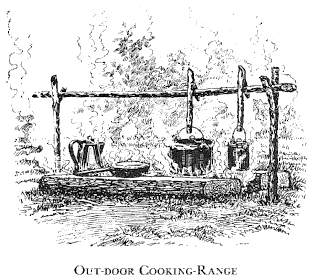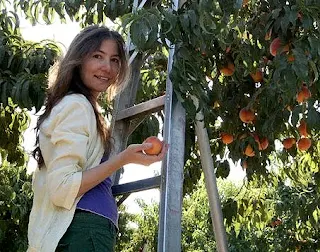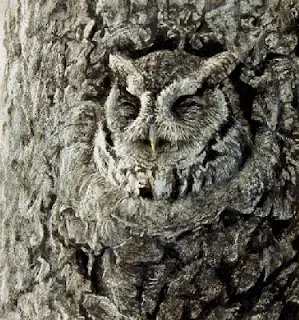21 September, 2010
To some people, planting a tree is the epitome of the environmental cliche. Planting a tree seems so simple, so easy, so... low-technology. In the midst of the economic upheaval we are experiencing now, in the face of massive challenges such as peak oil and climate change, why should we plant trees? What good could it possibly do?
Sioux woman, carrying wood.
For as long as people have had fire,
women have gathered wood for hearth and home.
1. We will soon urgently need trees for fuel.
Space heating uses 30 ~ 40% of the energy consumed in our homes. Our current heating sources are primarily heating oil, natural gas, and electricity (from natural gas, coal, nuclear, and hydroelectric dams).
Heating with these sources is dependent on having an affordable supply of these fuels as well as an economy with decent wages and a safe and dependable infrastructure (pipelines, roads, extraction operations) to deliver the energy around the country. All of these ~ supply, economy, and infrastructure ~ are becoming less reliable.
In most of the non-industrialized world, wood is still the primary source of heating and cooking fires, and has been for thousands of years. Certain characteristics of wood give it an advantage over other choices: it can be stored and used as needed, it requires little up-front investment or special technology, it can be produced locally in most places, it can be renewed, and before deforestation arises, it is often relatively cheap.
How to be successful with an outdoor cooking range. The fire is of the first importance. Start it with fine kindling and clean, dry, hemlock bark. When you have a bright, even fire from end to end of the space, keep it up with small fagots of the sweetest and most wholesome woods in the forest. These are, in the order named, black birch, hickory, sugar maple, yellow birch, and red beech. The sticks should be short, and not over two inches across. Split wood is better than round. The outdoor range can be made by one man in little more than an hour, and the camper-out, who once tries it, will never wish to see a "portable camp-stove" again.
As the production of fossil fuels wane, and their cost waxes, I believe that wood will eventually return to dominance as the heating fuel of choice in our part of the world as well.
Ideally, we would all have Earth-sheltered or passive solar homes that require little to no heating fuel. However, without proper initial design or timely retrofits, most people will heat with wood again in the long run ~ hopefully in a sustainable and healthy way, by reducing our need for heating fuel and by using efficient technologies and forestry practices.
If an area has an abundance of forests, wood from trees may be able to be harvested sustainably. If not, the area will likely experience deforestation (with all the problems that entails) and will have to import fuel, or may even be eventually abandoned.
Sun-warmed peach jam during the icy winters.
2. Trees provide food.
Trees produce many different types of fruit (apples, peaches, pears, oranges, plums, figs) and nuts (pecans, almonds, chestnut, walnut), which offer an important source of fat, nutrition, taste and sweetness. Unlike annual crops, trees only need to be planted once, minimizing soil and nutrient loss, and are easy to integrate into an urban landscape.
Using permaculture techniques, a "food forest" can integrate trees with shrubs (blueberries, blackberries, raspberries), perennial vegetables and herbs (thyme, oregano, mint, rosemary, etc), and even annuals. This approach to food cultivation creates a more stable and diverse ecosystem, since the soil does not need to be plowed and planted every year. It also yields a significant amount of food per square foot.
More and more people are beginning to recognize that industrial agriculture is unsustainable due to the massive quantities of fertilizer and oil required to lubricate the system that is destroying our biodiversity, our topsoil and our wildlife. If we want to have fruit in a post-peak world, we may need to grow it in our own neighborhoods ~ or within a few miles.
3. Trees can be a source of income.
Local food and fuel are poised to return to the prominence they enjoyed for all of human history (except the last forty years). Someone will need to provide that food and fuel, but many people in densely populated cities don't have room to grow their own fruit, nuts, and firewood, or they simply don't know how.
People who have the space, the knowledge, and the foresight to plant now can help meet the critical need for non-fossil fuel subsidized food and fuel.
Trees can provide income year after year. A well managed forest can yield wood not only for personal use, but also for sale as firewood or lumber. An orchard can provide food for the family and for sale or barter. Anyone who plants trees for these purposes now could be investing in a source of income for years in the future.
The simple act of planting a $10 tree can yield hundreds of pounds (and dollars) of produce for years thereafter, with only a little yearly pruning, thinning and harvesting.
4. Trees can mitigate the effects of severe weather.
Well placed trees and shrubbery provide privacy as well as protection from the elements.
Scientists, farmers, gardeners, and people who live in canary areas (the poles, islands) are witnessing the effects of drought, habitat change, and ice melt. Over time, the changes will become increasingly more obvious, probably in the form of more severe weather.
Trees can help mitigate the effects of many types of severe and more extreme weather.
They hold the soil to prevent erosion from downpours and flash floods. Holding the soil (and decreasing the soil temperature via shade) also prevents desertification and dust storms.
The shade cast by trees decreases the effects of harsh heatwaves, and trees can usually survive drought much better than smaller plants. They can absorb carbon to help prevent the worst excesses of climate change, and they can provide habitat and food for other species that make up our ecosystems.
They hold the soil to prevent erosion from downpours and flash floods. Holding the soil (and decreasing the soil temperature via shade) also prevents desertification and dust storms.
The shade cast by trees decreases the effects of harsh heatwaves, and trees can usually survive drought much better than smaller plants. They can absorb carbon to help prevent the worst excesses of climate change, and they can provide habitat and food for other species that make up our ecosystems.
5. Trees make an area more livable.
Our lives are going to become more local. Perhaps we should start to pay attention to what "here" looks like, feels like, and can provide; pay attention to whether the places we live are places worth living. Trees help cool an area, cut electricity use and cost, and soothe the eye - all while providing the benefits mentioned above.
One of the easily anticipated effects of an unraveling economy and a declining supply of oil is a need for cheaper modes of transportation, namely biking and walking. If we are to transform our urban areas to be walkable and bikeable, we will need to make them more pleasant than the baked scrubby Bermuda strips that now predominate (in Oklahoma City, anyway).
A helpful, but perhaps overlooked,
way to encourage pedestrian transport
is to plant trees.
Trees not only provide shade, but in groups and clusters, they cool an area down. The difference between walking down a shadeless street vs. a shady street in 100+ degree heat can be more than 10 degrees ~ the difference between walking and staying at home, in my experience. Various sources estimate that trees shading a home can cut air-conditioning costs by 30-50%, which will also decrease the strain on our aging electrical grid.
When air-conditioning becomes unaffordable (or electricity becomes unreliable), shade from trees could make a place bearable. And shade is not just a matter of comfort, as many people (elderly, infants, people with health issues) can suffer from heat distress, and even death from heat stroke in extreme cases.
Not only are trees useful, but they are beautiful. Their green soothes the eye. Their spring blossoms remind us that winter's harsh reign is almost ended, and their multi-colored fall leaves remind us that the baking heat of summer is over.
We will need beautiful places to live once we can't escape to info-tainment all day long and a seaside/mountainside/forested vacation several times a year.
Any one of these reasons should be enough, but all of them together make planting urban trees, food forests, and managed woodlots an important part of any resiliency effort.
Trees aren't a cliche ~
they are a keystone of the environment,
and therefore, our future.
Since trees take many years to reach maturity, we need to plant a variety of fruit, nut, and shade trees now, wherever we can feasibly and safely do so. For food security, for heat in the winter and shade in the summer, for income, taste and nutrition, for a place worth living, plant a tree this fall.
The person who wrote this article left out a most important role of the tree. The tree in its natural state is home to birds and animals, insects, as well as food and sustenance. This owl is fully at home in his orchard apple tree.
Like every other 1950's child in America,
the following was the first poem I memorized in grade 1.
THE TREE
By Joyce Kilmer
I think that I shall never see
A poem lovely as a tree.
A tree whose hungry mouth is prest
Against the earth’s sweet flowing breast;
A tree that looks at God all day,
And lifts her leafy arms to pray;
A tree that may in Summer wear
A nest of robins in her hair;
Upon whose bosom snow has lain;
Who intimately lives with rain.
Poems are made by fools like me,
But only God can make a tree.












No comments:
Post a Comment
If your comment is not posted, it was deemed offensive.